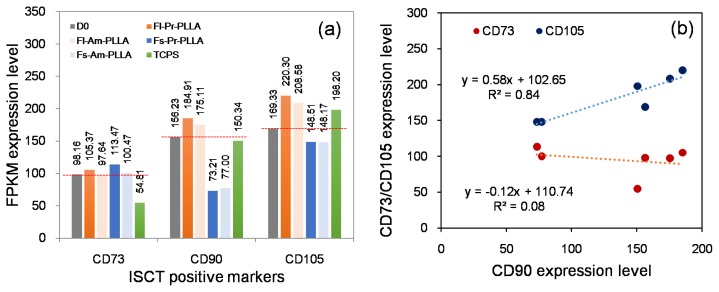The International Society for Cellular Therapy (ISCT) proposed a set of minimal markers for figuring out human mesenchymal stromal cells (hMSCs) in 2007.
Since then, with the rising curiosity of higher characterising hMSCs, numerous further floor markers have been proposed. However, the affect of how tradition situations, particularly, the tradition floor, fluctuate the expression of hMSC markers was ignored.
In this examine, we utilized the RNA sequencing information on hMSCs cultured on completely different surfaces to research the variation of the proposed hMSC biomarkers.
One of the three ISCT proposed constructive biomarker, CD90 was discovered to be considerably down regulated on hMSCs tradition on fibrous surfaces when in comparison with flat surfaces. The detected gene expression values for 177 hMSCs biomarkers compiled from the literature are reported right here.
Correlation and cluster evaluation revealed the existence of completely different biomarker communities that displayed the same expression profile. We discovered a listing of hMSCs biomarkers that are the least delicate to a change in floor properties and one other checklist of biomarkers that are discovered to have excessive sensitivity to a change in floor properties.
This examine demonstrated that substrate properties have paramount impact on altering the expressions of hMSCs biomarkers and the proposed checklist of substrate-stable and substrate-sensitive biomarkers would higher help within the inhabitants characterisation. However, proteomic stage evaluation could be important to verify the observations famous.

Natural ecotype of Arabidopsis thaliana (L.) Heynh (Chernobyl-07) reply to cadmium stress extra intensively than the delicate ecotypes Oasis and Columbia.
Large areas polluted with poisonous heavy metals or radionuclides had been fashioned as a facet product of fast industrial improvement of human society. Plants, as a result of their sessile nature, ought to adapt to those difficult genotoxic environmental situations and develop resistance.
Herein, we evaluated the response of three pure ecotypes of Arabidopsis thaliana (L.) Heynh (Oasis, Columbia-0, and Chernobyl-07) to cadmium, utilizing discovery gel-based proteomics. These accessions are differing by stage of tolerance to heavy metallic in all probability achieved by numerous publicity to power ionizing radiation.
Based on the pairwise comparability (management versus cadmium-treated) we acknowledged 5.8-13.4% of recognized proteins as considerably altered on the presence of cadmium. Although the bulk of photosynthesis-related proteins had been discovered to be much less considerable in all ecotypes it was famous that in distinction to the delicate variants (Col and Oas), the tolerant Che accession might activate the mechanism preserving photosynthesis and power manufacturing.
Also, proteins modulating power price range by means of different route and mediating larger resistance to heavy metals had been upregulated on this ecotype.
Although we propose that regulation of enzymes appearing in peptide and protein synthesis, safety of the crops towards numerous abiotic stresses, or these neutralizing the consequences of reactive oxygen species are quite related to common response to cadmium, they had been discovered to be altered extra intensively within the Che accession. Thus, the recognized affected proteins might characterize good candidate molecules for molecular breeding to enhance tolerance of crops to heavy metallic stress.
